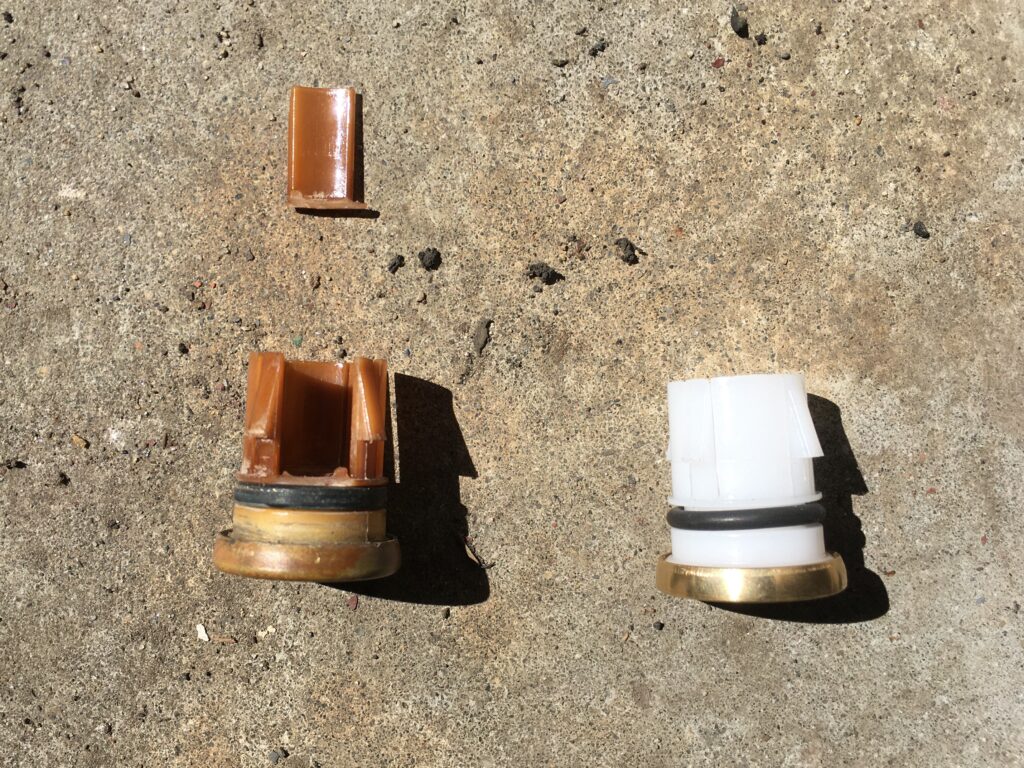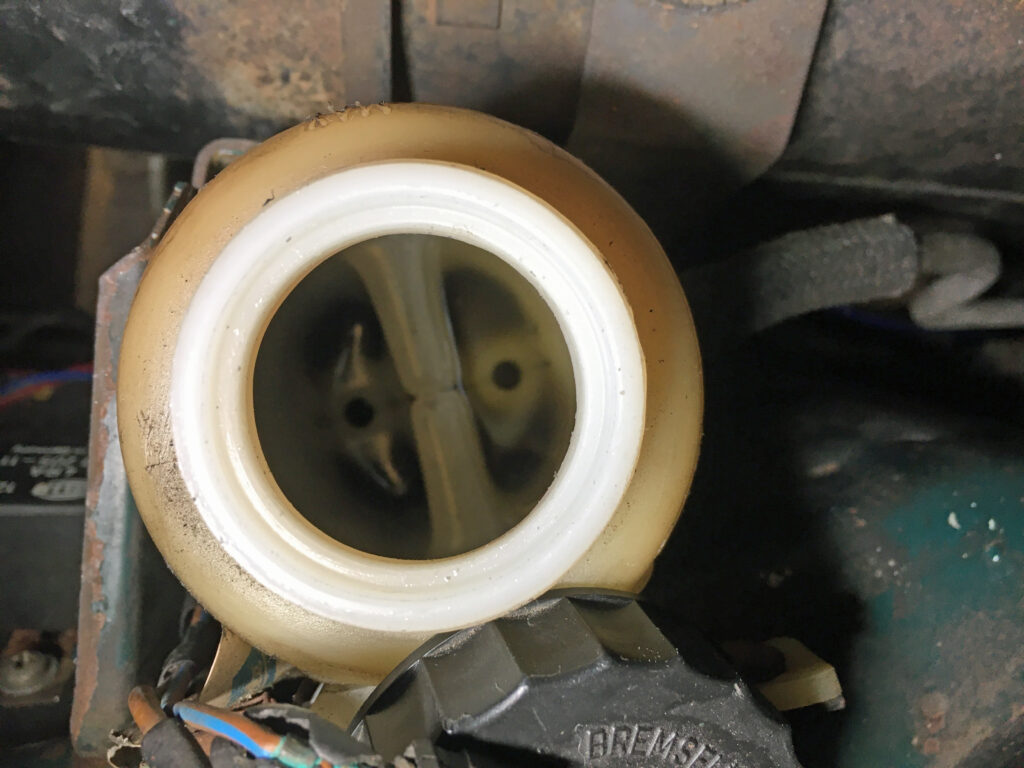Last week, I wrote about driving the clownshoe out to the warehouse in Monson on the MA/CT border to retrieve the Lotus Europa which had been sitting there since September. Unfortunately I found that the Lotus had a fuel leak from bad o-rings at the bottoms of the Stromberg’s float bowls, and when I tried replacing one of them, the plastic plug it was on broke apart. So I thought I’d take the opportunity to get Sharkie, my ’79 Euro 635CSi inspected out in Monson, but as detailed last week, a broken bracket on the emergency brake handle made that impossible, so I wound up taking Sharkie home, fixing it, and getting it inspected near the house.
So this week I drove Sharkie back out to Monson, carrying the precious cargo of two new plugs and o-rings for the Lotus’ Strombergs (and precious cargo it was, as the pair of plastic plugs and rubber o-rings set me back eighty bucks). Installation went without mishap.

I don’t need to say which one is the bad one, do I?
With the Lotus leak-free, I not only drove it, I got it its first inspection on its new Massachusetts plates.

Yay Lolita!
Since all five of the cars in Monson needed inspection stickers and I’d checked off the first two, I addressed the next three. I began with Louie the ’72 2002tii (the Ran When Parked car). There aren’t electrical outlets I can use for trickle chargers in the Monson warehouse, but my experience has been that unplugging the negative battery cable in the fall and reconnecting it in the spring usually results in a battery that still has enough juice to crank the engine over, and the battery is usually recharged on the drive home. If the battery is more deeply discharged than that, I press the battery jump pack I bring with me into service. However, for some reason, this trip pushed the batteries in three of the cars to their limits—while Sharkie and the Lotus snapped to attention during last week’s trip, this time the three remaining cars suffered from depleted batteries. And more.
I addressed Louie first. The engine cranked, but slowly. I connected the jump pack and it fired up and settled into a lovely low idle. I remembered that when I went through this same exercise with Louie last year, I found that the brake fluid reservoir was nearly empty but I couldn’t find any fluid anywhere under the car. At the time, I refilled the reservoir, checked for leaks, couldn’t find any, got the car inspected, and drove it home (stopping at rest areas along the way to double-check) so I could find fix the problem, but I never found the source. This week’s experience was an exact repeat of last year—the fluid reservoir was again empty, drained past the feed line to the clutch master cylinder, which means that the leak is coming from the brake hydraulics, not the clutch. But I didn’t see fluid either on the ground or running down the insides of the tires.

Yeah, that’s not good.
I keep supplies like a small floor jack, a cigarette-lighter air compressor, a multimeter, oil and antifreeze, starter fluid, paper towels, gloves, and after last year, brake fluid, in the warehouse in the trunk of the Bavaria, so I was able to top off Louie’s reservoir. As I did last year, I stomped on the pedal and still didn’t see any leaks, then took the car for a short careful drive, crawled under it with a flashlight, and found it still dry. The clutch pedal felt like it didn’t have enough travel, but the fluid being below the clutch line implicates brakes, not clutch. Nonetheless, I pulled the rug back to look in the pedal box, and found it dry. So it’s still a mystery. I got Louie stickered, then returned him to the warehouse. I’ll bring him home and again try to solve The Great Louie Brake Fluid Mystery, but not today.

Louie Louie, oh baby, we gotta stay.
Next was Bertha, the ’75 2002 that I transmogrified into a 2002ti tribute car. I reconnected its battery, but I didn’t even get a click from the starter solenoid. I checked the battery with the voltmeter and found it completely drained, like 10.5 volts, so using the battery jump pack was a must. The car sputted into consciousness. As with Louie, I checked underneath it for fluids, didn’t see any, then checked the brake reservoir just to be thorough, and was stunned to find that it too was very low. Not as low on Louie—it was about at the level of the clutch line, though due to the elevated position of the camera, that’s not clear from the photo below.

Did Bertha catch whatever Louie’s got?
I took Bertha for a short drive, and it ran like a 50 pound bag of manure. That triggered a memory of a rough-running issue from last year, but it had gotten worse. I cut short an uphill drive through twisties just east of Monson center because the car barely had enough power to get up them. I did sneak it through inspection, then returned it to the warehouse, with an ever-lengthening to-do list forming in my head. Whenever I do bring Bertha home, I may need to tow it—I’d be brazenly risking a breakdown by driving it the way it is. Of course I do now own the 2008 Nissan Armada, and justifying its existence by using it to drag Bertha home would be oddly appealing.

It’s out-and-back-in for Bertha.
Lastly was the Bavaria. Its battery was the most drained of the bunch, down to a likely-damaging 9 volts. The big Bav always is recalcitrant regarding starting after a winter-long sit, as the Weber’s float bowls are always empty and it has the old-school mechanical fuel pump, so it takes a far amount of cranking to fill the bowls. I’ve taken to temporarily splicing in an electric fuel pump to prime them, but I’d forgotten to bring it. Still, there was starting fluid in the trunk, so I hooked up the battery jump pack and pulled the top off the air cleaner so I could goose it. Unfortunately, when I tried to spray the starting fluid, I found that the propellent in the can was empty.
I put the Bavaria on the back burner for a moment and made sure to change the DampRid in all the cars. As I mentioned last week, last fall the Monson cars had big mold and mildew problems that I addressed by putting not one but two refillable DampRid containers in each car along with an industrial-quality desiccant brick used on container ships. This spring, none of the cars showed any mildew, but I wanted to maintain the momentum.
It’s surprisingly time-consuming to pull the containers out of each car, walk them outside the building, drain the water, clean them out, and refill them. By the time I was done, it was nearing 3 o’clock. One of the reasons for this trip to Monson was to get the Lotus inspected, then bring it home with me, but due to the certainty of rush-hour traffic, that window was at its close. The Lotus is an addictive little waif of a car, more fun than one 65-year-old guy should have on small well-paved twisty roads, but it’s bordering on terrifying in stop-and-go interstate traffic. It’s more than fine in terms of keeping up with traffic speed. It’s the visibility that’s the problem, and I mean that all three of the ways you can interpret it. People either don’t see it at all since the windows of their SUV are two feet above the roof, or they see it and try to snap videos and almost swerve into it. And from inside the car, the rear visibility is absolutely horrible. The rear window is literally just four inches tall, and the two side mirrors are the size of a purse makeup case. And all this in a fiberglass-bodied car with all the crashworthiness of a Little Tikes Cozy Coupe. Oh, and although the brakes work fine, the lack of brake boosters makes for tiring stop-and-go driving. For all these reasons, running the Lotus back and forth to Monson on the Mass Pike is best done in the middle of the day or on weekends.
I decided to take another run at getting the Bavaria inspected. I was about to run to the AutoZone in nearby Palmer for a can of starting fluid, but I first thought to check the car’s registration. Sure enough, it had expired at the end of March. I’d renewed it, but had forgotten to bring the new registration with me.
So I called it a day. I pulled the little Group 26R battery out of Bertha to take it home with me, fully-charge it, and then test it. I probably should’ve done the same with Louie’s battery, but it wasn’t nearly as dead, so I left it in place. The battery in the Bavaria is substantially bigger and heavier, and I really don’t want to blow five months of physical therapy with one hasty lift, so I left all the Bav’s issues for another day and drove home in the clownshoe, and when I hit the expected traffic, thought “right call.”
But (to channel Carrie Bradshaw) I couldn’t help thinking—Exercising the fleet was turning into exorcising the fleet.
—Rob Siegel
____________________________________
Rob’s newest book, The Best of The Hack Mechanic, is available here on Amazon, as are his seven other books. Signed copies can be ordered directly from Rob here.
Tags: brake fluid car care lotus Siegel





















